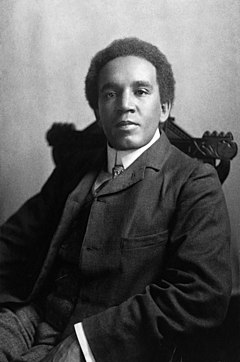Hiawatha’s Wedding Feast
| The Song of Hiawatha | |
|---|---|
| Trilogy of cantatas by Samuel Coleridge-Taylor | |

The composer
|
|
| Catalogue | Op. 30 |
| Language | English |
| Based on |
The Song of Hiawatha by Henry Wadsworth Longfellow |
| Performed | 1900 |
| Hiawatha's Wedding Feast | |
|---|---|
| Performed | 8 November 1898 |
| Movements | nine |
| Scoring |
|
The Song of Hiawatha (full name: Scenes from The Song of Hiawatha by Henry Wadsworth Longfellow), Op. 30, is a trilogy of cantatas written by Samuel Coleridge-Taylor between 1898 and 1900. The first part, Hiawatha's Wedding Feast, was particularly famous for many years and made the composer's name known throughout the world.
Hiawatha's Wedding Feast consists of nine sections: eight for chorus and orchestra, and one, "Onaway! Awake, beloved!", for solo tenor and orchestra.
In 1898, Coleridge-Taylor was fresh from his success with his orchestral Ballade in A minor, which was performed at the Three Choirs Festival of 1898 after Edward Elgar had recommended him as "far and away the cleverest fellow going amongst the younger men". Having been greatly inspired by his reading of Longfellow's epic poem The Song of Hiawatha (even later naming his own son Hiawatha), he decided to set the words to music in a choral work called Hiawatha's Wedding Feast.
The score was completed in May 1898 and was published by Novello before the first performance was given. Interest in Hiawatha's Wedding Feast was so great from sales of the music that, even before a single note of the work had been heard in public, Coleridge-Taylor was commissioned to write a sequel, The Death of Minnehaha.
Great publicity preceded the premiere of Hiawatha's Wedding Feast, and many people were refused admission, but one person who was accommodated was Sir Arthur Sullivan, who said: "I'm always an ill man now, my boy, but I'm coming to hear your music tonight even if I have to be carried." The premiere took place on 11 November 1898 at the Royal College of Music under the baton of his teacher, Sir Charles Villiers Stanford. (Some sources say the composer conducted the work himself; however, others make it clear that he was so shy that Stanford had to leave the stage to seek him out in order to coax him up to the stage to receive the audience's applause.) Sir Hubert Parry described the event as "one of the most remarkable events in modern English musical history". The success of the work was immediate and international.
...
Wikipedia
